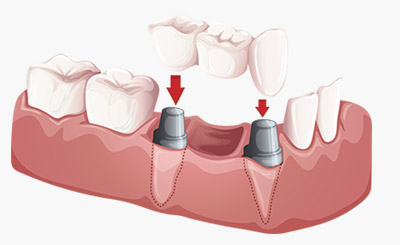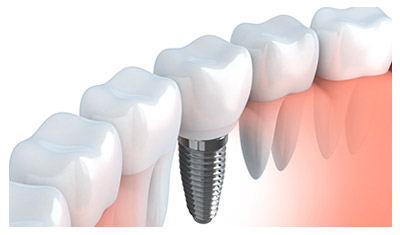A titanium screw is placed in the jaw and a false tooth is attached onto the titanium screw for a permanent fixed tooth.
Implant Dentistry
- Home
- Implant Dentistry

What is a dental implant?

Why choose Dental Implants?
- Implants can last a life time if they are cared for.
- They are a permanent replacement for missing teeth and will also continue to support the bone structure in the jaw.
- They are one of the best long term solutions to replacing missing teeth.
- They look, feel and function like a natural tooth.
- They are strong and durable given that they are cared for properly with regular dental check ups.
- Dental implants often improve the confidence of patients who once were uncomfortable smiling.
- They are a long term solution to replacing missing teeth.
Are You a Candidate for Dental Implants?
-

Existing Medical Conditions
If you can have routine dental treatment, you can generally have an implant placed. While precautions are advisable, patients with such chronic diseases as high blood pressure and diabetes are usually successful candidates for dental implant treatment.
-

Gum Disease
Almost all implants placed in patients who have lost their teeth to periodontal disease or decay have been successful.
-

Currently Wearing Partials or Dentures
Implants can replace removable bridges or dentures, or they can be used to stabilize and secure the denture, making it much more comfortable.
-

Problem Teeth
Almost all implants placed in patients who have lost their teeth to periodontal disease or decay have been successful.
-

Smokers
As with most things they are never 100% guaranteed. But if patients are willing to care for them with regular dental check ups, interdental cleaning using floss, tepes etc then implants have a very high success rate. Dental implants have a higher failure rate with people with medical conditions such as diabetes , periodontal disease.
-

Bone Loss
Bone loss is not uncommon for people who have lost teeth or had periodontal disease. Oral and maxillofacial surgeons are trained and experienced in grafting bone to safely and permanently secure the implant.
What does the Implant surgery involve?
Examination
The initial appointment will be a consultation to discuss all the options avilable to you for replacing the missing teeth. If Dental Implants are possible to replace the missing teeth, we will carry out radiographs and make study models of your jaws. In some cases you may need to have a CT scan, which is a 3D image of your jaws. This is a great benefit for dental implant planning as the scan assesses the bone levels and will locate all nerves, so there will be a reduced risk of damage to nerves.
Dental Implant Planning
Once the dentist has all the information required, they can plan for placement of the dental implants. The dentist can now assess if bone grafting would be needed. In some cases the bone levels are too low to place an implant directly into the bone – in these cases the dentist would need to carry out bone grafting first. Bone grafting is a procedure where the dentist takes bone from another part of your body and places it at the site where the implants would be. The bone graft will take around 3-6 months to fully heal. Once this has healed and further checks have been made to assess the bone levels, the implants can be placed.
Dental implant placement surgery
At our practice we always carry out a 2 stage procedure. The dentist will make a small incision where the implants will be placed and will use a small drill to shape the implant site. The implant will then be fitted into the bone and a cover screw is placed over the top of the implant. The gum is then sewn up over it for the period of healing. A second procedure is needed to uncover the implant via a small incision in the gum and attach the healing cap. Then, after the gums have healed, the healing cap is removed and replaced by the abutment, in readiness for the new crown.

Preparation of teeth and impressions
When your gums have fully healed and the implant has had time to heal around the bone (about 3-6 months depending on site) your dentist will take a new impression of your mouth. This will be used to make a model of your teeth on which the dental technician will construct your crown or bridge, paying special attention to achieve a natural finish that matches the rest of your teeth.
Fitting of crowns or bridges
When your new crowns and bridges have been prepared, your dentist will cement them on to the abutments over the dental implants, assess the appearance and fit, and check that your upper and lower teeth work together comfortably when you bite. You will usually need to return for several review appointments to make sure that the implants are stable and functioning well, and that you are completely happy with the finished result.
-
Earlier this year I had three of my upper front teeth removed and two implants fitted to carry a bridge. The extractions, implant procedures and final installation of the bridge all went smoothly. I felt comfortable throughout and did not experience any significant pain or post-event complications. The work was carried out by Mr Handa, who impressed me from the start with his professional and friendly approach. He put me at ease and I felt confident he would do a good job. I believe it was largely due to his practical skill that everything went so well. I am very pleased with the result. The new teeth feel much more natural than a denture and look better than the ones they replaced.
Find out what we've done for our patients.
Look at examples of Implant Dentistry in our Gallery.
